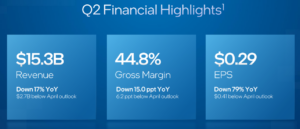Intel hits rock bottom – but can it make a comeback?

- The majority of the shortfall in Intel was caused by a slowdown in the economy, and mainly its failure to produce better products on time, Gelsinger said.
- Intel saw an unexpected 16% drop in revenue from expensive server chips that power data centers, dragging down overall sales and profit in 2Q22.
- The chipmaker also said that it needs more time to make its products competitive.
- Revenue for the year is expected to slump by as much as 13%.
- Experts suggest that Intel may never have hegemony in the PC and datacenter segments again, with AMD, Nvidia, Arm and TSMC around.
Over the past few years, chipmaking giant Intel Corp has been using the shotgun approach in an attempt to remain competitive. Yet, looking back at all the changes and new projects Intel has announced in the last few years, ranging from 5G modems to the Altera acquisition, none of them has actually shown any potential of bringing the company back to its former glory. That is especially apparent if we look at the company’s most recent quarterly earnings. As CFO David Zinsner puts it, “We are at rock bottom.”
“This quarter’s results were below the standards we have set for the company and our shareholders. We must and will do better. The sudden and rapid decline in economic activity was the largest driver, but the shortfall also reflects our own execution issues,” CEO Pat Gelsinger said during the company’s second quarter earnings briefing.
To put into context the decline in earnings Intel has just experienced, revenue in the second quarter fell by 22% to US$15.3 billion, significantly below the average analyst’s estimate of US$18 billion. Per-share profit, excluding some items, was 29 cents, Intel said, while analysts had predicted 69 cents. Sales in the current period are forecast to be as low as US$15 billion, compared with projections of US$18.7 billion, and gross margin will narrow to 47%.
Intel also saw an unexpected 16% drop in revenue from expensive server chips that power datacenters, whhich dragged down overall sales and profit. Intel admitted that as much as prices are falling, customers have also been turning to rival providers for their orders. To top it off, second-quarter sales for Intel’s datacenter division — where the company generates an outsized portion of its profit — slid to US$4.6 billion.
Now, the company expects its datacenter business to grow more slowly than the overall server market this year, Gelsinger said. “It’s not a fact we like,” he added. Client computing, Intel’s PC-chip unit, saw sales plummet 25% to US$7.7 billion. The company’s new target for 2022 revenue is as low as US$65 billion, representing a potential decline of as much as 13% from 2021.
The Network and Edge segment was the only one to perform slightly above expectations, at 2.3 billion, up 11% from last year. The Mobileye autonomous vehicle division is expected to be floated later this year. To reduce costs, fewer staff are being hired throughout the company, Intel said.

Intel’s Q2 financial highlights
The fall and fall of Intel
Over the years, Intel has been overtaken by several chip designers and chip manufacturers. Although the company was the absolute market leader with a lack of competition, it is lagging massively lately. While many Intel bulls believe that returning to fabs will be a turnaround for Intel, some experts don’t buy it, for two reasons.
First, Intel is simply too far behind to compete on fabs this decade without spending hundreds of billions of dollars per year just to catch up. As more of Intel’s business and clients go to Taiwan’s TSMC, the company will see cost-cutting and reduced budgets – budgets needed for advancing its tech and remaining competitive. An important point to note is that Intel wants to be a foundry that rivals TSMC , but still relies on the largest chipmaker in the world for some of its own chip production.
Therefore, as analysts put it, Intel is too far behind on the technology to offer a competitive advantage against TSMC. Intel today is viewed by many investors as having fallen behind rivals, and it draws unfavorable comparisons to Advanced Micro Devices (AMD) and Nvidia. Even last year, Intel struggled to capitalize on booming demand for chips — a surge fueled by the work-from-home trend and the spread of semiconductors into a wider range of devices.
In fact, Intel was the world’s largest chipmaker until 2021, when it was dethroned by Samsung. Though Samsung’s main business is memory chips, which is a different segment of the market to Intel’s microprocessors, it is a clear sign of Intel’s decline. Intel used to be the undisputed king of microprocessors. Although PCs were made by many companies, the prowess of the machines depended on whether they had an “Intel inside.”
Additionally, while the chip industry’s sales gained 26% last year to a record total of US$556 billion, Intel posted a 4% decline. The company’s rivals, meanwhile, have been flourishing. AMD’s sales grew 68% last year, while Nvidia posted a 61% gain. Those companies are on course to expand sales more than 25% again this year, according to analysts’ projections.
Intel has suffered multiple setbacks in the past two years. In 2020, the California company delayed the launch of its most cutting-edge chipset by two years, losing ground to competition. Then, Intel lost a lucrative and long-standing contract to supply chips for Apple’s Macs. Then came 2021, the ‘worse stage’ as experts would label it, when Intel began outsourcing production of its core chipsets to a third-party manufacturer, TSMC, for the first time ever. The reason? Intel’s own manufacturing plants were no longer advanced enough to produce the chips in-house.
According to Matt Bryson, an analyst at Wedbush Securities, there are two fundamental issues; “[Intel] fell behind AMD in chip design and TSMC in manufacturing.” Even during an earnings call with analysts earlier this year, Gelsinger had to concede that the technology in Intel’s data-center processors hadn’t been improved in five years. In his words, it was “an embarrassing thing to say.” Considering that, the tone has not changed much between then and now.










